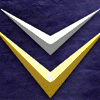This is a pretty good “I could have had a V8!” moment. As soon as I begin thinking about what I need to do to make a prototype of the Cold War Game... Duh... They forgot our little corner of history, of course they don't know how we made games! No wonder they don't understand how many of them I have made... at least 100. Duh... Like I said on my blog, I was lucky enough to meet a couple of the original Avalon Hill guys at a few different conventions in the early 1980s. The same two, always together. This first time I met them was a major epiphany moment for me, I was only 15 but had already essentially been designing games for half my life. Mostly in my head, like you think we do it. That's not how we do it. These two guys told me how we did it on that day, and now I will tell you. This isn't just about me. You aspiring game designers out their can use this to actually put what skills you may have to use, or learn that maybe you might not be right for this whole game design thing. And you industry veterans will understand what a valuable tool this is for you, as well, for certain types of games that you make. This won't help you with FPS, of course, but strategy games, RTS, lots of different games... it is a very valuable tool.
So I'll just show you how I will make this Cold War board game prototype, and you'll understand the whole thing. It really is very simple. I am going to have to buy a new “toolset”. That is what this is, no different than a mechanics rolling Snap-On tool box. What do I need? For the most part... Poker Chips and Dice. Cards. A map. That's pretty much it. I can do just about anything with this stuff. I haven't really needed this to write design docs for strategy games for many years, having countless combinations of things over 20+ years with my original toolset. But if I wind up succeeding this time I'll be needing a new toolset anyway... especially for Game #7! So this isn't just for this game, these toolsets last a lifetime.
It's a Cold War game. And a big map always makes things easier, so here is my map. The Cold War connection is actually irrelevant. This is the map I have always used for grand strategy wargame prototypes. There are two sizes. You normally use the small one because only big and successful games can have a big map. But for computer games, I would use the big map like I am. You have no reason to “contain the size of the design to the small map”, and this is always a lot easier on a bigger map. There is a large F&E map like this that comes in handy for space games:-)
https://boardgamegeek.com/boardgame/2851/supremacy-mega-map
Thank you, Robert J Simpson! The perfect prototype map of the world!!!
I've certainly already have all the dice I need. Cards are a lot easier these days... with a computer to print them instead of having to hand write them. I lost most my “toolset” in a move about 10 years ago, so I'll have to go buy at least 3 huge sets of poker chips (small, medium, and large). I'll get the cheapest ones there are that are just different colored plastic chips. As many different colors as I can get. If I wanted a more complete toolset I would then get the same poker chips sets all over again, except the second set has numbers on them.
I don't need anything for a board game version of this Cold War game, this is it. The small chips are the military units (they fit on map easiest). Different colors are different units. The large chips are money. The medium chips are stacked along the side of the map and represent “strategic level information/tracking”. In this cold war game, each minor nation needs to track “relationship level”, which superpowers side they are currently on. There are 5 levels... stack of 1-5 blue chips if on US side, stack of 1-5 red chips for USSR. The military units, can be a single stack... the “rainbow edges” show you what is there. Out at Sea... SFB counters. Done. Don't need anything else for this... and it is a VERY complex game. Axis & Allies x20, kind-of like the game I got this map from was:-)
Now for the “production version”, that if anyone out there wound up being interested in this later you might actually play. 2 copies of Axis & Allies (minor nation pieces). 2 copies of Fortress America (superpower pieces). Little pyramids, little blocks, and little rectangles to represent units not in A&A or FA. 2 copies of Supremacy... for the 24 little black nuclear mushroom cloud pieces. And with Supremacy I also get both the squares and rectangles from above, so now I only need the pyramids. Now I will get some decently nice numbered poker chips to represent the money. Sorry, I'm no artist, you'll just have to use the black and white text cards I was using all along.
That's it. The “production version”. Maybe now our methods are becoming a little better understood. As for my design documents that I write with computer games in mind. I said this to someone in e-mail and realize it's never been said here either...
My philosophy on my version of a computer game design doc. My design documents are designed to make a game the SFB Staff way with a modern game dev team. They are the staff. Your industry begins with what we would call a summary, but that is really all you need for the system you use which is a very valid system for your necessarily different process. My far more complete design documents are not taken to what you call “Beta”, ready for playtest, like my board game docs are. Instead, Pirate Dawn and other computer game design docs are taken to what you call “Alpha”. All of the components are there with their core content, and proven to function. My theory with this has always been that I help your process in doing this (and I did work at GameFX to experience that process). I am simply moving the bar of the starting point. You start with a summary, I start at Alpha... to begin your same exact process of the entire team, just like the SFB staff, continuing to evolve the game from that further ahead starting point. Almost like you normally start at a summary and work from there, where I am practically taking it to Pirate Dawn 1, so the game we end up producing in the end is closer to Pirate Dawn 2 because it was almost as if we already had a game out and are actually re-making it as a second version. Almost, because we started at Alpha instead of with a shipped game. So that has always been my theory behind this type of a design doc for a computer game. It's just a further ahead starting point for your own process.
So, if you are out there as a young person wanting to make games, this is how you do it for real. To experiment. With many types of games, not FPS or RPG or Adventure games for example, but you can make many types of games with these methods. And more than just strategy war games. This is only the beginnings of a tool set. The one I lost was 20 years of accumulation of buying stuff like this when needed. I don't even need anything with numbers on it for this game, so this is a very cheap setup. I really have designed at least 100 strategy games in my lifetime. At least. I often had three going at the same time all over my room to switch back and forth between as I had ideas for them, or they influenced each other!








